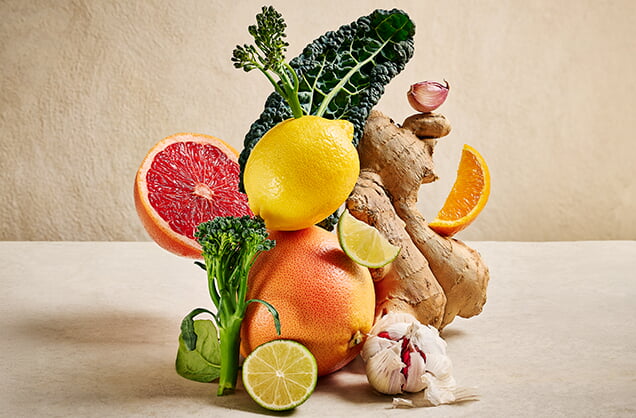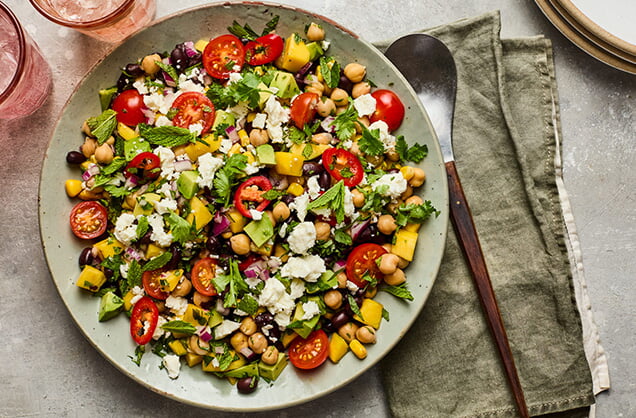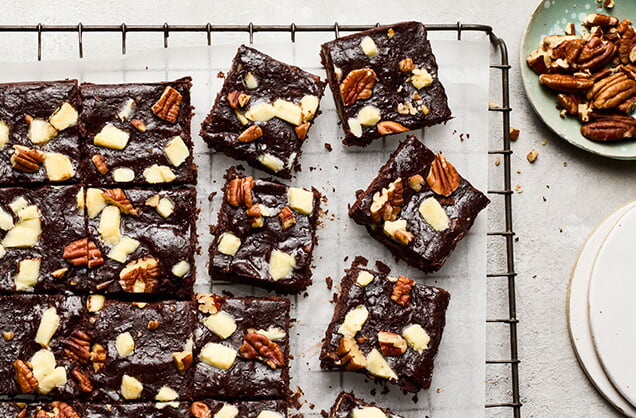What is fibre in food?
Did you know that fibre is a type of carbohydrate? It’s found in plant-based foods and your body can’t fully digest it. This is actually a good thing: fibre plays a vital role in helping your body run smoothly.
What's the difference between soluble and insoluble fibre?
There are two main types of fibre:
- Soluble fibre dissolves in water and forms a gel-like substance. It’s found in foods, such as oats, fruit, veg and beans, and helps you feel fuller for longer. It also helps to lower cholesterol and control blood sugar levels.
- Insoluble fibre doesn’t dissolve in water and therefore helps food move through your digestive system, which is great for regular bowel movements. It’s found in the skin of fruit and veg, wholegrains, nuts and seeds.
Does eating fibre help your gut health?
- Working together, these two types of fibre support your digestion and gut health by feeding your gut bacteria, otherwise known as your gut microbiome.
- There are almost 100 different types of bacteria and thousands of chemicals that feed different gut bacteria, so it’s key to eat a variety of dietary fibre from lots of different food groups.
Does fibre help with energy?
- The benefits of fibre don’t stop with your gut: fibre can also help manage your energy levels by keeping you satisfied after meals and giving you a steady stream of energy.
- It does this by helping to keep your blood sugar stable, so you can minimise any mid-afternoon crashes and stay energised for longer.
Does fibre help with blood sugar levels and cholesterol?
- Keeping your blood sugar in check is also important for a healthy heart, but fibre has another heart-friendly benefit.
- Soluble fibre helps to lower your LDL cholesterol levels – LDL stands for low-density lipoprotein, otherwise known as ‘bad’ cholesterol.
- The soluble fibre attaches itself to the ‘bad’ cholesterol particles preventing them from entering the bloodstream – pretty amazing!
- Mopping up this LDL cholesterol can protect your arteries and reduce the risk of heart disease and other heart-related conditions.

How much fibre should I be eating in a day?
The recommended daily amount for an adult is 30g, but most of us are only eating around 18g on average*.
What does 30g of fibre look like across a day?
Gut health scientist Dr Megan Rossi shares a daily plan that adds up to around 34g:
- High-fibre breakfast: Bowl of porridge made with 40g oats, topped with a banana and mixed seeds (around 8g fibre)
- High-fibre lunch: ½ tin of baked beans on a slice of multigrain bread with a handful of spinach (around 10g fibre)
- High-fibre dinner: Spaghetti Bolognese with ½ tin of mixed beans and 200g of frozen vegetables, served with 75g of wholemeal pasta (around 10g fibre)
- High-fibre snack: 30g of almonds and an apple (around 6g fibre)
As you can see, with a few smart choices, hitting your fibre target is totally doable, and it can be an affordable and family-friendly way to eat too.
What foods contain fibre and what foods are high in fibre?
You may be wondering what it means when a food is called ‘a source of fibre’ or ‘high in fibre’. Here’s a quick explanation:
- A food is considered a source of fibre if it contains at least 3g of fibre per 100g (or 1.5g per 100kcal)
- A food is labelled high in fibre if it contains at least 6g of fibre per 100g (or 3g per 100kcal)
Food labels can be a helpful guide when you’re shopping and planning meals, but you don’t need to rely on labels alone to help you eat food high in fibre. Fortunately, there are many everyday foods containing fibre, especially plant-based ones.
Foods that are good sources of fibre:
- Fruit and veg – especially when eaten with the skin on
- Wholegrains – such as wholemeal bread, wholewheat pasta and brown rice
- Pulses – like lentils, chickpeas, peas and beans – try our butter chickpea curry and freezer burritos for fibre-filled dinners, and this delicious dense bean salad for a nutritious lunch
- Nuts and seeds, including almonds, chia seeds and pumpkin seeds – have a go at these overnight oat buns for an energising breakfast As well as providing fibre, these foods offer vitamins, minerals and other nutrients that support your overall health, plus fruit, veg and pulses that help you towards your 5-a-day goal (that’s eating at least 5 portions of fruit and veg daily). Take a look at our 5-a-day recipes and tips for ideas.
Foods that are high in fibre
While all fibre sources are useful for a healthy diet (every little helps!), some high fibre foods deserve a special mention. If you can include a little of these high fibre foods in your diet, you’ll find reaching your 30g target so much easier.

How can I eat more fibre?
You don’t need to spend lots on expensive ingredients to include more fibre in your diet. With a few budget-friendly swaps and additions to your usual meals, it can be easy and achievable.
How to up your fibre intake:
- Add lentils or kidney beans to your mince dishes, such as spaghetti Bolognese, cottage pie or chilli con carne. Try baking with lentils too – our lentil brownies are a fibre-rich treat.
- Go for baked potatoes if you can, as potato skins are a useful source of fibre. Experiment with tasty fillings.
- The same goes for other veg and fruit – where possible, eat the skin for extra fibre. Check out these ideas for stems, leaves, peel and seeds.
- Swap crisps for popcorn – air-popped corn is wholegrain – or try making your own trail mix.
- You may have already heard of swapping low-fibre foods, such as white rice for brown rice, but consider pearl barley too. It’s satisfyingly chewy with a tasty nutty flavour.
- Try adding mashed butter beans or chickpeas to sandwich fillings for a protein boost. You could mix them with tuna or avocado.
Ideas for high-fibre meals and snacks
If you’re looking for meal ideas or snack inspiration, we have a whole section dedicated to high-fibre meals. These recipes have been devised to include food rich in dietary fibre, so you can enjoy delicious meals and reach your fibre goals.

How can I get more fibre into my family's diet?
Getting more fibre into your family’s diet needn’t involve cooking separate meals, even if you have some picky eaters at home. Here are a few tweaks and family-friendly meals to boost your family fibre intake – no one will notice a thing!
- Wholewheat pasta has a chewier texture than regular pasta; the same goes for brown rice over white. Try mixing half regular and half wholegrain to gradually introduce new textures.
- Add grated veg to your family favourites, such as pasta dishes, casseroles and mince recipes, like meatballs.
- At snack time, offer popcorn, oatcakes with peanut butter or houmous or make a homemade flapjack for a teatime treat.
- Add fruit and veg whenever you can: top cereal or overnight oats with fruit, stir peas into pasta and serve carrot sticks with houmous or a homemade dip for a tasty side.
- Top homemade pizzas or tortilla wraps with your favourite veg, such as pepper and sweetcorn.
The key is to keep it familiar, but also tasty and fun. Little changes can make a big difference across a day and a week and set up healthy eating habits for life.

Eating more fibre needn’t be about overhauling your whole diet. With a little know-how, a few clever swaps and some tasty high-fibre meals up your sleeve, you can enjoy food that’s both satisfying and good for you. Whether it’s adding beans to your chilli, choosing wholemeal bread or adding some fruit to your morning cereal, it all adds up.
High in fibre foods are often filling and flavoursome, keeping you fuller for longer and helping with your energy levels throughout the day. So, start small – try one of our quick swaps or introduce a new fibre-rich food this week and see where your fibre journey takes you!
*https://www.bda.uk.com/resource/fibre.html